SYNOPSIS
! SPOILER ALERT !
In a story arc
that started out in Iron Man
#35, branched out into Daredevil
#73, and is now being continued (and
concluded) in Iron Man #36, Iron
Man is being returned to Earth's
dimension and joins Daredevil, Madame
Masque and Nick Fury in their battle with
three Zodiac members (Capricorn,
Sagittarius, Aquarius) and Spymaster.
Once all is done
and dusted, Madame Masque - unaware of
Iron Man's secret identity - confides in
ol' Shell-Head and tells him that she
feels she should end her romantic
entanglement with Tony Stark. Keeping his
feelings to himself, Stark is terribly
upset by this, feels he needs a vacation,
and leaves the Stark Industries plant in
the care of Kevin O'Brian. However, all his
plans are interrupted by the arrival of a
gigantic android named Ramrod, sent out
to prepare for the arrival of a group it
refers to as the "Changers".
Stark suits up as Iron Man and tries to
take down the android, but overworks
himself in the heat of the battle,
resulting in too much strain on his heart
- Iron Man is down, and on the brink of
death.
REVIEW
& ANALYSIS
The Mighty
Marvel Checklist advertised Iron
Man #36 with the teaser "Tony
Stark says farewell to Iron Man! But
then, enter the sinister man-thing known
as Ramrod - and the golden Avenger must
live again - or a world dies!",
and that is pretty much what Iron Man
#36 is all about.
|
|
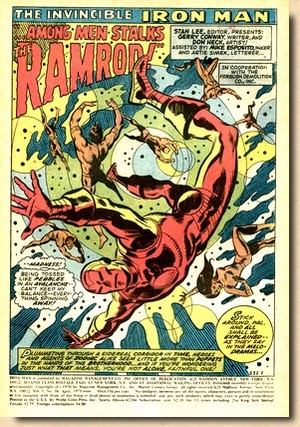 |
|
|
| |
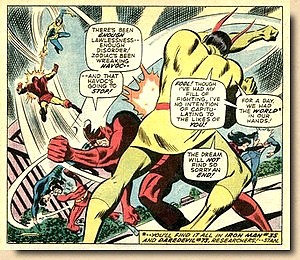 |
|
Essentially
your average Marvel fare, a few things about
this issue do stand out as
somewhat unusual.
Whilst continuing
storylines were a hallmark of
Marvel and an essential part in
building and advancing the
equally iconic background
continuity of the House of Ideas'
titles and characters,
multi-issue storylines would
usually start on the first page
of one issue and end on the last
or second to last page of another
issue. Iron Man
#36, however, ends a multi-issue
plot line in mid-issue and then
initiates another. In other
words: this issue contains both
the conclusion and the start of
continuing storylines.
Whilst not unique
to Iron Man #36
(an early example was the now
classic Fantastic Four
#48, which first wrapped up a
tale featuring the Inhumans and
then introduced the Silver Surfer
and Galactus), it was fairly rare
for writers to do this (and for
editors to be okay with it).
|
|
|
|
| |
| A lot more common were the title crossover stories,
and this is a typical 1970s example of how Marvel handled
these. The (utterly silly) Zodiac story started out in Iron
Man #35 and then branched out into Daredevil
#73, before heading back to Iron Man #36 for the
conclusion. There could be many
reasons for doing this. In some cases it could make sense
due to the main characters involved (such as the Dracula
crossover story with Doctor Strange in Tomb of Dracula #44 and Doctor
Strange #14 (both May 1976), but it
is fairly evident that in most cases it served as an
attempt to boost sales of one or both titles. In this
case, both Iron Man and Daredevil could do with an extra
shot in the arm.
"In those days, Daredevil
(...) sold fairly consistently, but not very well
(... ) Iron Man [was] another [such] book." (Steve Gerber in
Mithra, 1997)
Of course, back in the good old
days of the 1970s, Marvel would hope you would go out and
buy that other title, but they never truly required you
to do so. There would always be an explanatory splash
page and editorial filling you in on what had been going
on (in this case) in Daredevil #73; so even if
you jumped straight from Iron Man #35 to Iron
Man #36, you would not be too confused and still be
able to follow the overall plot.
|
| |
| Unfortunately, this
crossover had its footing in a rather
weak and confusing story involving
off-Earth action and a loose bunch of
B-list villains (three Zodiac members, of
which Sagittarius is misspelled Saggitarius
throughout). Thankfully,
it's all over by mid-issue, and as
Daredevil swings back into his own
adventures (and title), romantic problems
have Tony Stark dipping into another mood
swing that results in him brooding about
his motives for being a superhero. Is he
just hiding behind the mask? Should he
just pack up the suit for good and simply
turn to a life of fun as a playboy?
It's classic
"superhero with low
self-esteem" drama, but it doesn't
last long for Tony Stark to come to the
realization that being Iron Man is
actually the best thing he’s ever
done in his life - and that's just as
well, since another villain has just
appeared on the scene: Ramrod.
This stocky
blue-and-yellow robot mysteriously
descends from the skies, proclaiming that
his mission is to prepare for the coming
of the Changers. And he does so by
levelling multiple buildings and firing
energy blasts at anyone who dares stand
in his way.
|
|
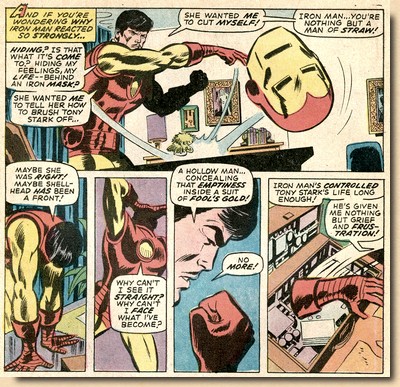
|
|
|
| |
| And so, Iron Man takes on the
(incredibly verbose and boastful) robot. The battle rages
back and forth (actually it's more of an up and down),
but at one point the Golden Avenger suffers a heart
attack and crashes to the ground.
This, of course, is Iron Man's original Achille's heel:
his weak heart (whereas the superhero identity crisis
witnessed only a few pages previously was a common Stan
Lee thread with most if not all of Marvel's heroes). |
| |
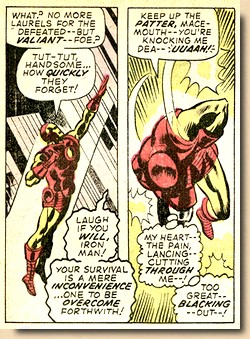 |
|
And so, Ramrod
proclaims not only the fall of
his adversary, but his death - to
be continued, of course.
Unfortunately,
the storyline introducing Ramrod
doesn't really compensate for the
below par Zodiac tale, leaving
readers of Iron Man
#36 with two different plots (one
that ends and one that kicks off)
in one issue but not much to be
entertained by - although it's
not all bad, since Gerry Conway
brings back Tony Stark's original
heart problems (seemingly taken
care of previously), adding
vulnerability and interest to
Iron Man and his alter ego.
Then again, even
Conway himself was critical of
this era of Iron Man:
"In
all honesty folks, it's a
mess [and] I'm forced to
admit, this is not out finest
hour (...) Give us all
[co-writers and artists] an
"A" for effort,
though (...) our final grade
for the course is probably,
at best, a C+. Chalk it up to
growing pains as Marvel moved
from being a small,
tight-knit group of
like-minded collaborators, to
a modern publishing
powerhouse with the ambition
(and sometimes, overreach) to
match. Like I may have
mentioned before, crazy
time." (Conway,
2011)
|
|
|
|
| |
| Back in early 1967 the almost
unthinkable had happened: Marvel had overtaken DC in
sales numbers and became the new number one of the
industry; it was now indeed the much heralded Marvel
Age of Comics. Only a year later, a change in
distributor set-up meant that Marvel was now free to
publish as many titles as it wanted, and the count went up accordingly from 14 titles in
January 1968 to 20 by July 1968. But even though Marvel
was the comic book industry's number one, DC still
published more titles until mid-1972 - when Marvel's
proliferation of titles finally turned that around too. |
| |
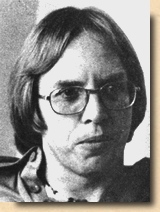
Roy
Thomas, early 1970s
|
|
"Marvel
suddenly decided to put out a whole bunch of
books (...) trying to get market share (...)
lots of stuff came out in the '70s because of
this approach." (Roy Thomas, in
Cooke 2001)
By June 1974 Marvel's
titles at the newsagents (45) outnumbered those
put out by DC (23) by leaps and bounds. But flooding the market this way
meant that the House of Ideas needed a
significant push for new creative talent.
"Marvel's
staff exploded (...) practically overnight.
Some of us knew more or less what we were
doing. Most of us, to be fair, didn't have a
clue (...) we were just making it up as we
went along." (Conway, 2011)
|
|
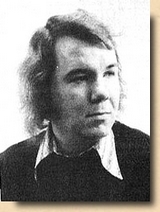
Gerry
Conway in 1973
|
|
| |
| For some of
the long-standing Marvel creative talents, this situation
could (and would) prove to be a challenge, and Don
Heck (1929-1995) would find himself to be one of them.
Best known for co-creating Iron Man, some of Marvel's
most classic artwork of the 1960s, and his long run on
pencilling the Avengers during the 1960s, Heck also
pencilled Iron Man #36. But in spite of being
one of the "original" Marvel artists, he found
his role at the House of Ideas had changed dramatically
by the early 1970s. |
| |
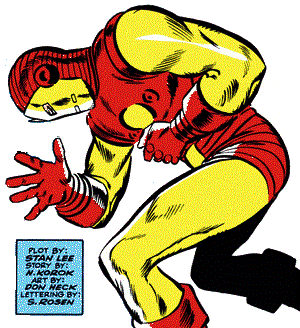
|
|
But unlike other
seasoned artists, Heck wasn't up
against newly appointed editors,
but Stan Lee himself.
"[Don
Heck] was very unhappy
because Stan would ask him to
do stuff that was more like
Kirby or Buscema and me (...)
I don't know why Stan gave
the impression that Don's
work needed to be fixed up a
little bit (...) Don was a
very good artist, but Stan
and he were constantly at
each other (...) he called
me, saying 'I don't know what
to do, I can't seem to please
Stan.'" (John
Romita Sr. in Coates, 2014)
Much later (and
on record), Lee characterized
Heck as "always a joy to
work with" and the "ultimate
professional" (Coates,
2014).
|
|
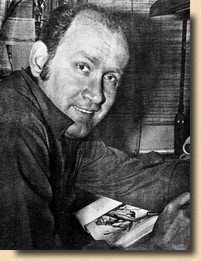
Don Heck in the
1960s
|
Things tend to mellow
down with hindsight, but back in the day,
Heck got increasingly frustrated with the
situation.
|
|
|
| |
On top of Stan Lee viewing his
pencils as "not Kirbyesque enough" (an ongoing
fixation at Marvel throughout the 1960s reported by
several artists), Heck's artwork was often spoilt by
assigning it to incompatible or lazy inkers.
"I
kept getting all the new inkers. Everyone who walked
in, I got them. A bad inker can kill artwork. I once
got some pages back from inking and I just tore them
up, that's how bad they were." (Don Heck in
Peel, 1985)
And whilst Heck was willing to
deliver artwork "no matter how tight the
deadline might have been" (Lee in Coates,
2014), even that began to backfire on him.
"He got the nickname
"Don Hack" but people forget that it was
Heck that a lot of editors went to when they needed
an entire book over a weekend. The inkers would then
have to rush through the job too. Then those same
editors would complain about the work. Well, just how
great are 22 pages going to be when you only have a
couple of days to draw them?" (Jim Amash in
Coates, 2014)
The ultimate insult, however, came
in 1980 in the form of an infamous interview in Comics
Journal #53, during which Gary Groth and Harlan
Ellison declared Don Heck to be the "worst artist in
the field". However, the two glib blabbermouths
actually confused Heck with Sal Buscema (Cronin, 2018) -
who obviously didn't deserve that kind of slander either.
|
| |
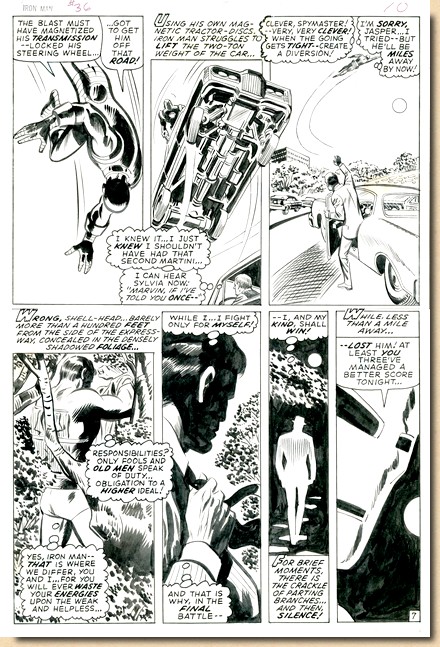 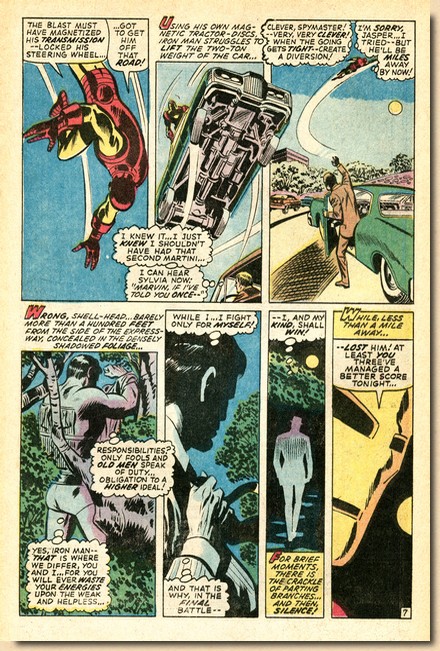
Original
artwork by Don Heck (pencils) and Mike Esposito (inks)
for page 7 of Iron Man #36 (scanned from the original)
and the same page as it appeared in print (colouring by
Sharon Cohen)
|
| |
| Heck's pencils for Iron Man #36 display a
little bit of everything; there are some beautifully
classic panels, and some lesser ones too, but they show
what his artwork could look like when inked on a good day
by an able craftsman such as Mike Esposito. As the 1970s rolled around, Heck was
handed fewer and fewer jobs at Marvel, and ultimately his
occasional assignments from rival DC Comics became his
mainstay. He left Marvel for good in 1977 and stayed with
DC until 1988 where, amongst other things, he put out
some extremely atmospheric artwork for the Jason
Bard backup feature in Detective Comics.
After that he picked up work for Marvel again, as well as
from a number of independent comic book publishers. He
died from lung cancer in 1995.
|
| |
FACTS & TRIVIA
Iron Man #36 came with the usual features - the
monthly Bullpen Bulletin (carrying another fan-favourite
alliteration headline, Wondrous words of wit and
wisdom with which to waste some time), the Mighty
Marvel Checklist (as always presenting a cornucopia of
wondrous imagination to readers with titles they might
never actually be able to lay hands on), and two pages of
letters (under the heading Sock it to Shell-Head).
|
| |
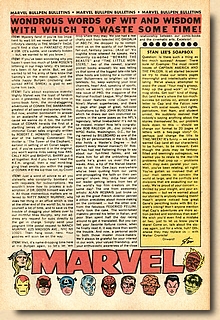 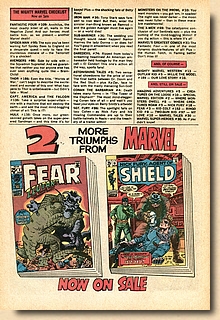 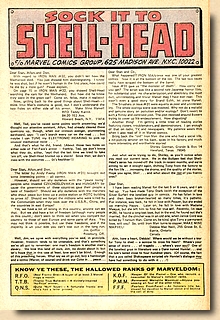
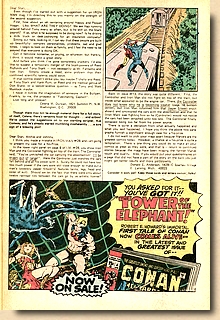
|
| |
| All of this was garnished with
colourful and exciting advertising. Definitely a Marvel forte,
it was an integral part of the house style and made comic
books from the House of Ideas ("more triumphs
from Marvel") a groovy and exciting experience. |
| |
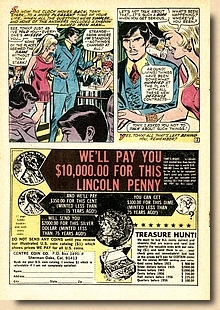
|
|
One thing,
however, made Iron Man #36 stand
out from the rest: two
so-called half-pages. Found
fairly frequently in DC comic books at the time, the
procedure of spreading one page of artwork across
two actual pages in the finished product (in
order to spread out the space for in-house or
third party advertising), Marvel used them on
rare occasions in the early 1970s only. They were
very unpopular with the fans, and a
"revival" by DC in 2015 caused quite a
stir (Beebe, 2015).
When Marvel published Fantastic
Four #1 (November 1961), the story page
count stood at 25, but this dropped to 23 once
letter pages were introduced. By the end of 1964,
the number of story pages dropped to 20 plus 2
pages of letters (except for the anthology titles
such as Tales of Suspense which held on
to 21).
|
|
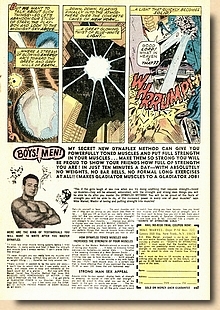
|
|
| |
| The page count then dropped in early 1970 to 19 pages
- in the case of Iron Man, this change was
ushered in with issue #24 (April 1970), whereas issue #23
(March 1970) still featured 20 pages of story. The price
remained unchanged at 15¢ The
half-pages therefore didn't actually cheat readers - they
still got the 19 pages they normally would - but it
didn't look and feel right to most readers, and Marvel
quickly reverted back to the strict separation of content
and advertising pages. Much later, in 2011, when Iron
Man #36 was reprinted in volume 7 of the Iron Man
Masterworks, the two half-pages were spliced together as
a single page.
|
| |
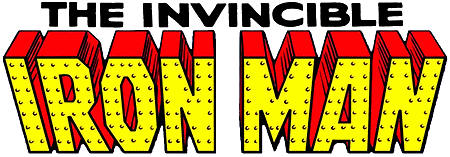
|
| |
| FURTHER
READING ON THE
THOUGHT BALLOON |
|
| |
 |
|
You can read more
about the "war of the
shelves" raging between
Marvel and DC in the early 1970s
here. |
|
|
|
| |
| BIBLIOGRAPHY BEEBE
Reed (2015) "Mars
comments on Twix ads controversy", nothingbutcomics.wordpress.com,
published online 8 June 2015
COATES
John (2014) Don Heck - A Work of Art, TwoMorrows
Publishing
CONWAY
Gerry (2011) "Iron in the Fire", Marvel
Masterworks Iron Man Vol. 7, Marvel
COOKE Jon B. (2001)
"Son of Stan: Roy's Years of
Horror",
in Comic Book Artist #13
CRONIN
Brian (2018) "Don
Heck Reacts to the Infamous Comics Journal Harlan Ellison
Interview", cbr.com,
published online 27 March 2018
MITHRA
Kuljit (1998) "Interview with Steve Gerber", manwithoutfear.com
PEEL
John (1985) "A signing session with Don
Heck", in Comics Feature #34, March/April
1985
|
| |
| |
The
illustrations presented here are
copyright material.
Their reproduction for the review and
research purposes of this website is
considered fair use
as set out by the Copyright Act of 1976,
17 U.S.C. par. 107.

(c) 2024
|
|
|
|